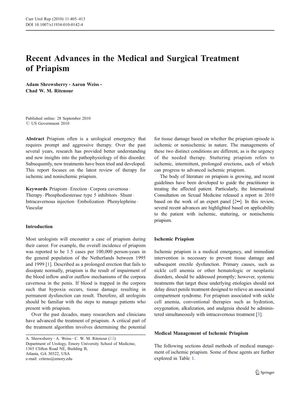Recent Advances in the Medical and Surgical Treatment of Priapism
September 2010
in “
Current Urology Reports
”

TLDR New treatments for long-lasting erections improve outcomes but must be timely to avoid lasting damage.
The 2010 document reviews advances in the treatment of priapism, a condition of prolonged erections that can cause tissue damage and erectile dysfunction. It differentiates between ischemic priapism, which is an emergency requiring immediate treatment, and nonischemic priapism. Medical treatments for ischemic priapism include intracavernous injections of sympathomimetic agents like phenylephrine, with success rates between 43% and 81%. Other treatments for recurrent ischemic priapism include oral medications and self-injection of sympathomimetics. Surgical options for ischemic priapism include distal and proximal shunts, with success rates of 66% to 74% for distal shunts and higher rates of erectile dysfunction post-surgery. Nonischemic priapism can resolve spontaneously in up to 62% of cases, but selective arterial embolization using permanent or nonpermanent materials is recommended for treatment, with resolution rates around 75%. Permanent materials, however, have a higher incidence of erectile dysfunction (39%). The document underscores the importance of timely and appropriate management of priapism to prevent long-term complications.
